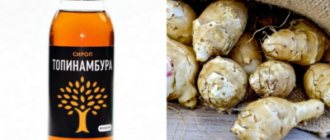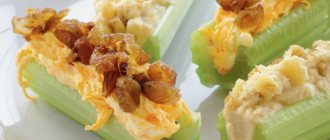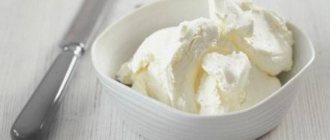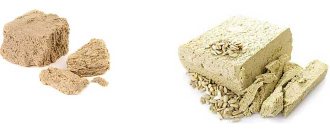About churchkhela
Everyone likes the dessert, but women try to avoid consuming it due to its high nutritional value. It contains large amounts of glucose and fructose. Their share reaches half of the total weight of the product. Churchkhela is rich in vegetable fats and organic acids. It contains much more potassium, iron, phosphorus, calcium and magnesium than regular fruits. At the same time, you should not abuse it, since the calorie content of 1 piece. churchkhela is about 198 kcal.
Grape juice can be replaced with any other, for example, apple or pomegranate. You can use dried fruits instead of nuts.
Properties of churchkhela
How much does churchkhela cost (average price for 1 kg)?
Moscow and Moscow region.
890 rub.
The Georgian national delicacy called churchkhela is popular not only in its homeland - it is enjoyed in Armenia, Azerbaijan and even in Russia. This delicacy for us product consists of nuts strung on a thread in grape juice thickened with flour.
Churchkhela is distinguished by its high nutritional qualities due to the high content of glucose and fructose, proteins, vegetable fats, organic acids, phenolic and nitrogenous substances, as well as vitamins. The calorie content of churchkhela is 410 kcal per hundred grams of delicacy.
Today there are many varieties of churchkhela. Thus, the traditional Georgian, Imeretian, Gurian, Rachin, Abkhaz and Mingrelian sweet products stand out, each of which differs in appearance and its own taste characteristics. However, in all recipes for this delicacy, all 4 stages of preparing churchkhela can be traced in general terms. Usually it is not customary to store it for more than a year, since the sweetness can be prepared again during the next grape harvest season.
Classic Kakhetian churchkhela, which is the most common type of this sweet dish, is made using grape juice of white varieties, and the press fractions that are richest in extractive substances are used. The juice is boiled for about half an hour, after which it settles for at least 10 hours.
The clarified grape juice is filtered and evaporated in boilers, and then settled again to allow the sediment to settle. The already viscous mass is slightly heated and mixed with wheat flour. With continuous stirring, the required degree of thickening is achieved.
The readiness of the mass is checked by immersing nuts strung on threads into it. For better adhesion of the mass, the churchkhela is dried for about 2 hours, after which the immersions are repeated until a layer of grape mass is formed approximately two centimeters thick. Churchkhela needs to be dried in the sun for about half a month. The finished product is placed in boxes in layers, overlaid with cloth, and kept in a cool, dry place for two to three months until ripening.
It is during the aging process that churchkhela acquires its characteristic taste properties - tones that are close to chocolate. For the filling, walnuts, hazelnuts, almonds, raisins, as well as peach and apricot kernels are mainly used. The kernels are soaked in water and as soon as the skin comes off, they are briefly boiled in a weak sugar solution.
In addition to Kakheti, other types of churchkhela are also produced in Georgia. But the technology for their production differs in the quality of the flour used, the composition of the filling and the mode of preparation of the juice. Most often, churchkhela is found in resort towns on the Black Sea coast of Georgia and the Krasnodar Territory.
Beneficial features
Grape juice, which is one of the main components of the dessert, is very beneficial for the body. It contains a large amount of pectin, the main property of which is the ability to reduce cholesterol. It has a beneficial effect on the liver, stomach, and lungs. Grape juice normalizes the functioning of internal organs and allows you to treat some diseases.
Antioxidants contained in grape juice help get rid of cardiovascular problems. And it is also believed that grape juice has a depressant effect on cancer cells.
The high calorie content of churchkhela makes it an excellent option for a snack. Its small volume can quickly satisfy hunger, restore strength and energize.
Why is churchkhela harmful?
Despite the natural composition of the dessert and the huge amount of useful substances, the product cannot be consumed by everyone.
Since the calorie content of churchkhela per 100 grams of product is just over 400 kcal, it should not be eaten by people who have problems with excess weight. The large amount of sugar makes it contraindicated for diabetics.
It should be avoided by those who have diseases such as liver cirrhosis and tuberculosis. In addition, doctors recommend that pregnant women avoid churchkhela. Churchkhela should not be eaten by those with allergies to grapes, nuts and other sweet components.
Traditional cooking recipe
Many people think that preparing delicious churchkhela on your own is very difficult. This is not true, it is much more difficult to wait until it is ready to eat. This will take several weeks.
The ingredients you will need are a liter of grape juice, half a kilo of walnuts, and half a glass of flour. It is thanks to its composition that the calorie content of churchkhela is so high.
You need to string nut kernels onto a thick thread threaded through a needle, 0.3 m long; it is recommended to leave about 5 cm of thread free. The end is fixed with a match.
All flour is carefully mixed with 0.3 liters of grape juice. You should get a homogeneous mass without lumps. The remaining juice must be brought to a boil and combined with a mixture of flour and juice. The mass should be thick, similar to glue. Its temperature should be about 50 degrees. A thread with nuts is dipped into it for a few minutes, then it is dried in air for about 5 minutes. A similar procedure is performed several times until the layer of juice is 1.5–2 cm. After this, the dessert should dry. When the churchkhela becomes hard on top but remains soft inside, then it will be ready for consumption. The calorie content of churchkhela with walnuts (one piece) is slightly less than 200 kcal.
DIY delicacy
Now let’s figure out how to make churchkhela in our own kitchen. Agree, not everyone has a real Georgian living near their home who is putting it up for sale. But I want to enjoy it.
- Take a strong thread and a thick gypsy needle. Nuts (in the original walnuts) are strung on a string.
- A glass of flour is kneaded in a small amount of self-squeezed grape juice until lump-free, filtered and poured into a container with the bulk of the juice (there should be a liter in total).
- The mixture is boiled over low heat until the color changes to deep burgundy.
- If the grapes are sour, dissolve 5-6 tablespoons of sugar in the juice, although this is not according to the rules.
- Each string of nuts is held by a loop and dipped in syrup. Properly welded, it will practically not drain from the “beads”.
Dipping should be repeated several times, after the previous layer has dried, so the wrapper on the nuts will be thick. Afterwards, the threads are hung in the kitchen, and after a week you can begin testing. In the East they are kept for 2-3 months, but hardly anyone has the patience to wait that long.
From cherry jam
Extra cherry jam can be a great substitute for grape juice. The only condition is that the product must be seedless. In order to use a glass of jam for churchkhela, you will need 0.3 kg of walnuts and half a glass of corn starch.
The nut halves need to be strung on a thread so that you get whole nuts.
A similar volume of water is poured into the jam, everything is placed on low heat. Constantly stirring the liquid, it must be brought to a boil.
Starch must be dissolved in water, the substance should be thick enough to resemble sour cream. It must be carefully poured into the pan with jam, constantly stirring the mass. You need to cook until the mass thickens. Then you need to dip the threads with nuts into it. It will take no more than 5 days for such a churchkhela to ripen. Then it should be cut into pieces and served. Despite the excellent taste, you should not get too carried away with this sweetness; you need to remember the high calorie content of churchkhela.
How to cook churchkhela at home
Churchkhela at home, prepared according to ancient recipes, is a wonderful delicacy. Slices of nuts are strung on a thread, after which the whole thing is lowered into a bowl with thickened, boiled grape juice, which should cover each nut. Then the thread is taken out and dried in the sun. After a few hours, the procedure is repeated until a layer of a couple of centimeters is formed on top of the nuts, after which the thread with nuts is dried in the sun for two weeks. Then the churchkhela is placed in boxes for two to three months, after which the delicacy acquires a wonderful taste and appearance - nuts covered with sweet dried grape juice.
Churchkhela made from mixed nuts
Despite the fact that the classic recipe prescribes making churchkhela from walnuts, experiments are possible. The taste can be made more interesting by using several types of nuts. To prepare six servings of this delicacy, you will need a nut mixture: walnuts (0.5 kg), almonds (0.2 kg), hazelnuts (0.3 kg). For this volume of nuts you will need 3 liters of grape juice and flour (2.5 cups).
The technology for preparing churchkhela does not differ from the classical one. But first you need to dry the almonds and hazelnuts in a frying pan for 5 minutes. Then you need to rub them in your palms. The calorie content of churchkhela in one piece is about 200 kcal, which will quickly satisfy your hunger with a healthy product.
The minimum aging period for sweets is 2 weeks. But if you let it hang for a few months, it will taste much better.

Everyone will like this tasty stick. There is no need to avoid this dessert due to the fact that it contains many health benefits. But the product has certain contraindications, primarily due to the high calorie content of churchkhela.
Churchkhela
The name churchkhela comes from the Georgian word chuch-khela (dried seedless berries), one of the most ancient delicacies of the Caucasus. During long campaigns, warriors and shepherds needed long-lasting, high-calorie, nutritious food. Hearty churchkhela was ideal for this purpose; it retained its nutritional properties for a long time and did not require special storage methods.
Churchkhela resembles twisted candles or a string of beads, usually from 25 to 50 cm long. Churchkhela is nuts strung on a string, completely covered with grape juice syrup. The color and size of churchkhela depends on the type of nuts and juice used. The most common churchkhela is made from walnuts and grape juice, burgundy-brown in color, with a specific honey aroma and sweet taste. Churchkhela has a dense, sometimes slightly rubbery layered structure.

Calorie content of churchkhela
The average calorie content of churchkhela is 410 kcal per 100 grams of product. Depends on the ingredients and method of preparation.
Composition and beneficial properties of churchkhela
Natural churchkhela should contain nuts (walnuts, hazelnuts, almonds, peach or apricot kernels, sometimes raisins), juice (grape, pomegranate, apple) and flour (wheat or corn). The presence of citric acid (calorizator) is allowed. The presence of sugar indicates that production technology was violated. Churchkhela is a filling product that provides energy for a long time, so it can serve as an ideal snack at work or while traveling.
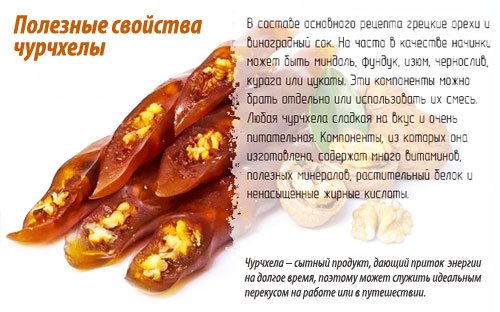
Harm of churchkhela
Churchkhela is a high-calorie product, so those who are watching their weight should not get carried away with it. Nuts and juices can cause allergic reactions.
Types and production of churchkhela
Churchkhela is produced in many regions of the Caucasus, so each has its own poetic name. Abkhazian, Georgian, Gurian, Imeretian, Lechkhumi, Kartli, Kakheti, Mingrelian or Rachin differ in color and appearance. The methods for producing the national delicacy are almost identical and involve several stages.

At the first stage, the juice is prepared, which is boiled several times, boiled, thawed and filtered. Then the juice is heated to 30 °C and sifted flour of the finest grinding is gradually introduced, constantly stirring the mass to prevent the appearance of lumps. Prepared (dried or soaked in water) nuts are carefully strung on harsh threads and slowly dipped into syrup. The threads are hung to dry for several hours, then the dipping procedure is repeated 3 to 7 times. The churchkhela is finally dried in the fresh air under the sun; the process takes two weeks. The dried churchkhela is placed in wooden boxes, covered with paper or cloth, and left in a cool, dry room for 2 months. Churchkhela prepared in this way is the most delicious and healthy.
Selection and storage of churchkhela
When choosing a delicacy at the market, you need to carefully examine the churchkhela - the surface should be glossy (matte indicates that a lot of flour was added to the syrup to thicken it as quickly as possible), dry and not stick to your hands. Churchkhela in vacuum packaging must be selected according to its composition, which should contain only natural ingredients, without sugar and its substitutes.
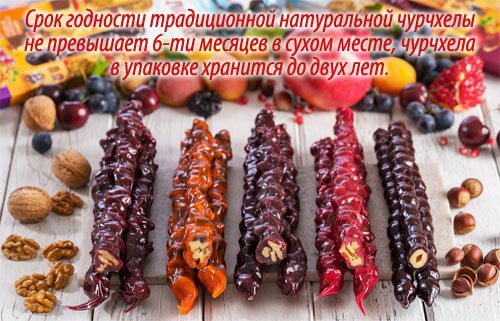
The shelf life of traditional natural churchkhela does not exceed 6 months in a dry place; churchkhela in packaging can be stored for up to two years.
Churchkhela in cooking
Before eating, you need to remove the thread from the churchkhela, then the delicacy can be cut into arbitrary pieces, broken or bitten off from the whole “sausage”. Churchkhela is an excellent healthy dessert for tea, a snack or an original snack for dry wine.
For more information about churchkhela, watch the video “How to cook churchkhela” on the TV show “About the Most Important Thing.”
